A Tutorial in Digital Fine Art by Khobe
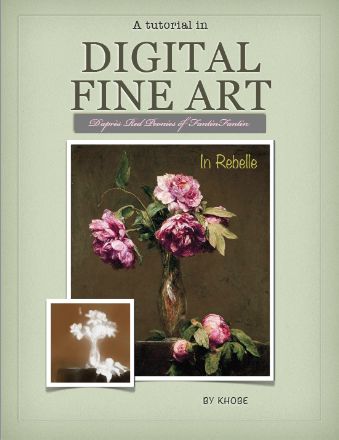
Acknowledgments
I would like to acknowledge the hard work and vision of the whole Escape Motions team. I was given the opportunity to test Rebelle’s alpha versions. The official released versions that followed kept getting better. These people are devoted to bringing forth their dreams into the world by making wonderful and innovative art applications for visual artists of all venues. No doubt they are trailblazers in the jungle of the art applications realm. I know because I have a few of the best under the hood of my computer. Not only does Rebelle hold it’s own in that impressive crowd, but it manages to be one of the most intuitive art programs I’ve ever used.
Rebelle allows me to make my painting studies in it before I jump on the material canvas, or make my virtual paintings for other graphic art projects like this PDF tutorial series. It offers the best of both worlds.
The learning curve of any application can clip the wings of your imagination before you start making any kind of art, if the logistic is too complicated. This is the big plus with Rebelle. I can dive in it the instant inspiration strikes because it’s so easy to use and has impressive natural art medium rendering. It gave me the incentive to write these instructional lessons because the attention can be mainly focused on making art instead of tweaking the program.
My definition of genius goes like this: take something complicated and make it simple, useful and accessible for the rest of us_ then you’re a genius. Rebelle’s designers and programers fit this definition on all counts. Rebelle is a lightweight application that packs a heavy punch. This virtual atelier is a real a winner!
Khobe
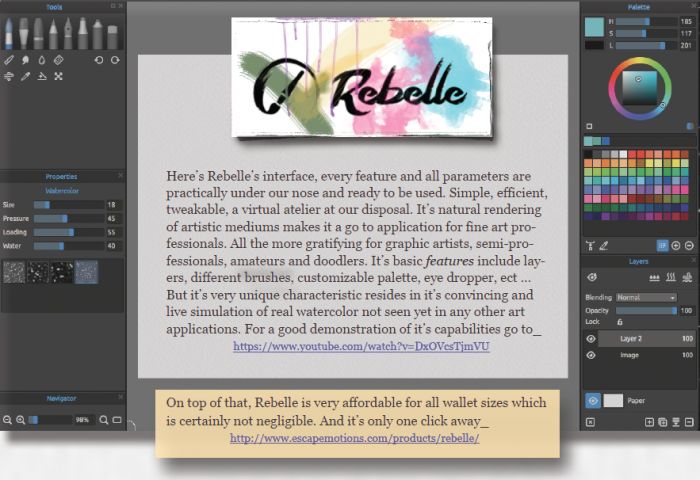

Preface
Drawing and fine art seem to be enjoying a kind of popular come back or revival nobody expected ten to fifteen years ago. When I was studying in art school, the traditional fine arts were declared dead and buried more than a century ago. Any young artist wanting to learn the academic craft had nowhere to turn to, but most of all was assured to have no future.
The cultural scene was rather bleak for those who had a thirst for this perennial knowledge of the great masters. At the time I remember it felt like taking a hike on foot in the desert without water and a compass. The only avenue left in art was to go into the advertisement business or technical drawing, I did both to my dissatisfaction and frustration. For the rest I trained myself intuitively the best I could, trying to figure out the forgotten techniques these masters had taken to their grave.
The desolate landscape of those years was not wasted on me though because I kept practicing my skills feverishly. In retrospect it was a very good thing because it was the perfect excuse to seriously study art history formally, but also independently. What I gained for my personal culture was precious and useful in this instance, in fact it proved essential! I trained myself in intense focused observation to extend my concentration of mind for long periods of time (a discipline in itself!) Also searched how-to art books that could get me closer to the secret, they were rather rare and mostly written by artists like me on the hunt for the mythical treasure. They had deciphered on their own a method to read the ancient map but had not come very far. At least four generations of artists before my own deeply felt the pain of this loss and complained about it, the likes of Degas, Van Gogh, Salvador Dali to name a few.
A majority of young artists from the last quarter of the nineteenth century had taken a more commercial route. Illustration for books and magazines became a very big thing for young artists back then, stabilizing their income, turning publicity into a huge industry. Those who stayed behind in the fine art galleries were facing financial hardship, so they tried to reinvent themselves understandably and the craft or what was miserably left of it. The techniques of the old masters were being forgotten at an accelerating pace.
Naturally there were epic talents also that had gone to the heights of the traditional craft in the same period, the likes of John Singer Sargent, Childe Hassam, Thomas Moran. The bostonians_ the first painting school having an impressive number of women masters like Lilian Prescott Hale, Mary Danforth Page, Gretchen Rogers, Marion Boyd Allen, Edith Scott and Adelaide Cole Chase. The men were no less a remarkable crop of great painters like DeCamp, Vinton, Paxton, Hunt, Chase, Cole, P.L.Hale and Winslow Homer.
In Europe William Bouguereau, Phillip de Lazlo and all the russian impressionists like Ivanov, Polenov, Repine, Levitan, Serov, Shishkin and Arkhipov were the art giants of their day.
They were the nobility's portraitists or themselves well enough in the bourgeois society to make their name respected in the artistic milieu crowd and the famous salons, a world onto itself. but they were all about to be swept away and mostly forgotten after the first world war_ a world had disappeared.
Most people would be shocked to learn that Pablo Picasso admitted honestly and publicly he was cheating his rich ignorant clients out of their money by making bad art, the more stupid the more they would pay. At the end of the day he said he was not deluding himself believing he was making masterful works of art. In his own way he was expressing the deep crisis of a shattered fine art world. In the early twenties of the last century some artists went the way of a parallel research to new discoveries in quantum physics about space/time geometries like Escher. These puzzling geometric explorations totally fascinated me as a teenager, still do today to a very high degree (including fractal art).
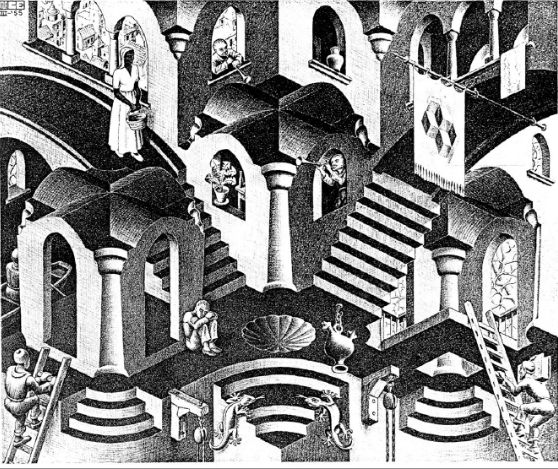
This transition from academic to modern art has a very strange political history to say the least, the further we forward to our times. I don’t want to go deep into this subject here. But it is common knowledge now that art was used extensively in communist propaganda, by the nazis and by the military of all nations. The twentieth century wasn’t only about wars, but also covertly to the weaponizing of art to fabricate consent, conditioning the collective psyche to make war. We are now reaching the peak of this ugly manipulation of and by design of the collective unconscious.
It was Edward Bernays, Sigmund Freud’s nephew who back in the day sold this lucrative idea to government agencies and corporations. It didn’t fall on deaf ears. But the cherry on that sunday is, the secret subsidizing of artists like Jason Pollack by the CIA, to bring them to commercial prominence in the artistic world as a psyop during the cold war. This was another blow against academic art.
The use of subliminal art suggestions in publicity and the medias is to this day used to control the public’s psyche and trigger consumer desires. This dark side or seductive abuses of art for less than friendly ends sadly is too rarely spoken about, if not a taboo subject for too many artists. Be reassured my goal in this tutorial is not about exposing bad politics for which I’m not inclined, it’s about the old masters’ technique
My long search was finally rewarded, with the teachings of excellent academic fine art masters I met who taught me in private.
In this tutorial drawing techniques will be elaborated on specifically by way of sketching. It cannot replace lessons with a live master, but with a few of my cues your art can really benefit. This is not an empty promise.
FIRST THINGS FIRST
No artist is an island no matter how original any of us would like to be...whatever that means... and in case if you want to reinvent the wheel you should feel free to do so, but it would be like missing the point of originality from the get go, wouldn’t it?
In art all subjects are fair, it’s about what impresses and exalts our sensitivity, our sense of aesthetics and what resonates inside our psyche given the treatment of a subject. From one artist to the next this can differ to the extreme, incidentally you will have to make your own choices from that point on.
Marie-Antoinette’s dressmaker was a clever lady, so I guess she kept her head during the french revolution. She became famous with a few of her short à propos sayings like « There is nothing new but what has been forgotten». I guess refering to more than just fashion. Keeping in mind those wise words, I’m inspired by what has been forgotten in art to trigger my creative imagination. In fact there is no bigger pool to tap into. Following this advice I practice art like so many did before me but in my own way, finding it so incredibly rewarding. Anyway what is new under the sun?
The love of art is borderless and timeless.
The way of art has the power to rekindle the soul,
truly a formidable enemy of boredom.
Art is from universal spirit !
The Red Peonies reproduction painting is a study entirely done in Rebelle, proving fine art can be done easily in a computer program, and artists can master this tool like any other for the benefit of the traditional craft and their own. There is an impressive bulk of traditional fine artists now working in concept art, fantasy art and illustration, environment and character design for the video games and films industry. These great masters are of immense talent to be reckoned with like James Paick, John Berkey, Linda Bergkvist, Olivier Ponsonnet, Karl Poulson, Hong Kuang, Linda Tso, Henning Ludvigsen, John Howe and Syd Mead. They have been resuscitating the traditional craft from the digital world, you can rest assured though, they all did their artistic homework.
I always admired the great works of classical fine art, specially the masterful paintings of the last quarter of the nineteenth century masters, I equally love art history. To my knowledge traditional fine art painting was brought to the highest degree of refinement and bravura in that specific era, has not been technically surpassed yet, except by those artists who learned from these old masters. To arrive close or push this high bar is a feat the new tools are here to help with but remember they don’t do anything by themselves, reminding we must keep things in perspective so to speak. Artists from the renaissance on have approached scientifically the problems of spatial perspective and composition of 2D to suggest 3D space with the application of pure geometric principles. Their approach qualifies as artistic engineering very prevalent behind classical art. Art veils prudishly it’s science under the enchanting garment of beauty, as it must.
This was inspired by the archeological discoveries of the antique statuaries being dug up from the early trecento cultural renaissance revolution. These finds coincided with a time of need to redefine man’s place in the world right after the great european plague, where two thirds of the population literally disappeared. At the same time a catastrophic global economic depression hit, the likes of which has not been seen since, though we’re getting close to another now and for the same reasons. That double catastrophe broke the old medieval mentality, seeding a new earth centered mental mode different of the religious other worldly salvation concepts of the middle ages. You can say this art was born from big labor pains, so the word renaissance meaning reborn is definitely appropriate.
Let’s come back to the academic drawing technique to understand basic notions coming from the craft’s traditional past, a time when words themselves conveyed deeper meaning. In French it’s still more evident_ drawing is dessin, in old french «dessein» pronounced both the same, they shared equally the meaning of drawing AND destiny. Both words and the English word «design» all derive from the Latin_ dei signo_ meaning divine sign. They are related closely to words like divination and symbol (a reminding sign) giving access visually to the spiritual realm and the sacred.
Today we are far from attributing these qualities to drawing. To me though it’s still sacred in the sense of a psychological and cognitive necessity. The old masters’ technique is fluid and very refined, intelligent and efficient. With this technique you don’t actually draw, it’s all about sketching to make the drawing appear, never drawing directly. Basically it’s making spatial connections in a progressive and organically repetitive and corrective process.
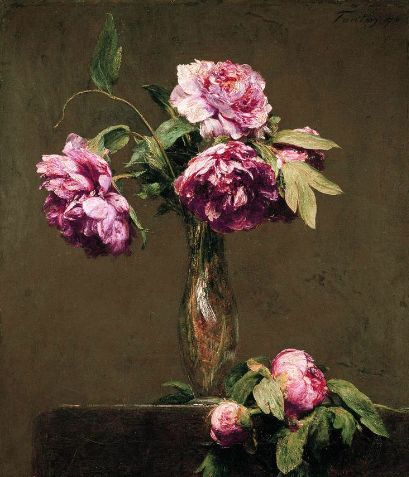
The Red Peonies, original oil painting by Fantin Latour
A Solid Base
Strangely enough our greatest enemy when we dare tackle the great classical artworks is our inner critic. This inner shadowy entity can be mean and cruel sometimes, it can stab our heart with the most lethal invectives. Believe me I had my epic struggles with this insidious nemesis, the dark side of ego. What it taught me is not to give up on myself. Don’t be afraid to confront it and it will retreat. Go slow and easy on yourself at first, you don’t want to injure your budding inner artist. And remember to keep breathing naturally while you’re sketching and drawing, otherwise you’ll start shaking, thinking your hand is no good. The other pitfall is expecting to be exact with the first strokes, right on the spot never erasing. This is fantasy having nothing to do with the reality of making art. If you want to get into the zone you need to be relaxed, repeating and correcting until you get it! And It takes the time it takes to get it, so this is where you need to be graciously patient with yourself. So pick up your pencil or stylus and breathe the process. Stay light and loose, always start with suggesting the whole instead of details or risk losing a part of your subject, this is crucial to get to the finish line in one piece.
Make your next move ONLY when satisfied with the current one, don’t be afraid to go back if you missed something. Darken ONLY when every element in the sketch is correctly in place.
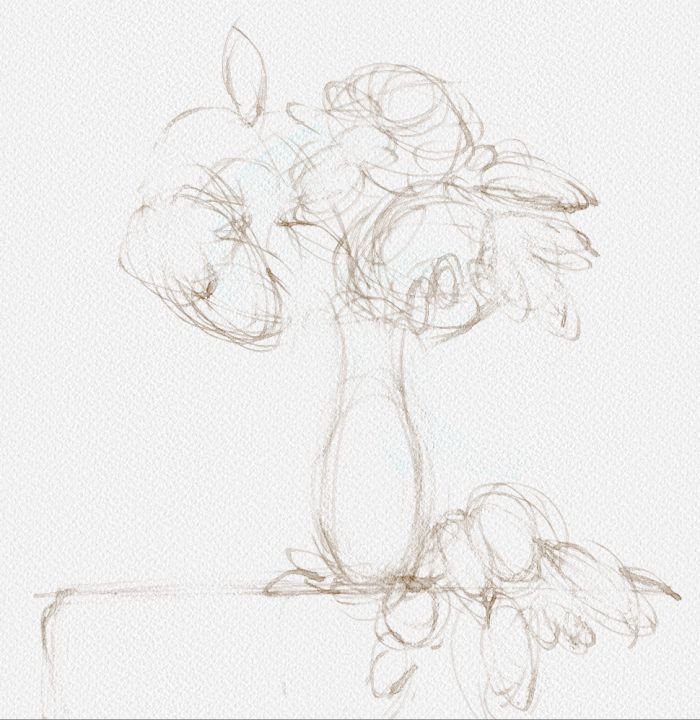
The Red Peonies Sketch ready to paint
As you can see here no straight lines except the table, and even that is the result of circles of which I erased the biggest part_ so it would look straight. When I sketch I use my eraser as much or if not more than my pencil, charcoal stick or stylus. The secret is to stay light as long as it takes to insert ALL corrections not to damage the paper also avoiding troubles going over the basic sketch. I use the exact same technique on the canvas or computer; good old fine art loose sketching!
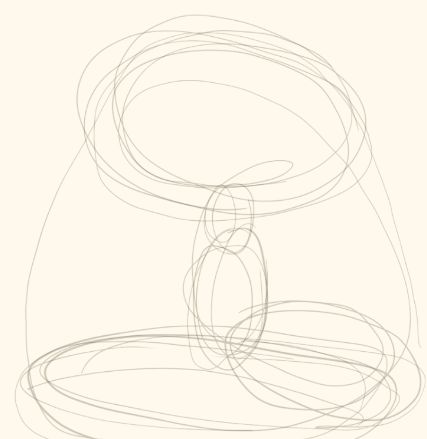
"La jetée" is the first very rough sketch, no frills. I just place my whole biggest inclusive shape on the general surface, treated in a linear fashion from the greatest shape to the smallest, in that order. With this kind of approach you don’t see the subject, you only see shapes in space, and you want to keep seeing your work that way as long as possible.
It's like lassoing your subject gently and slowly tightening the noose a little more from big to small with each intervention, while your eye adjusts slowly to relative proportions to each other in the general topography of the subject.
Nobody even a master doesn't see with great precision from the first look, only amateur believe such a thing exists. Amateurs don't want to mind the basic sketch too long, they're in a hurry to get the finished drawing. A master does the opposite, stays in square one and the rest of the process is reassessing the basic sketch, refining it to turn it into a work of art.
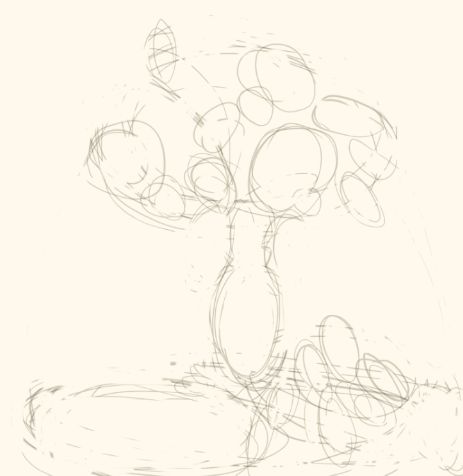
Staying in the process, I delineate the shapes slowly with my eraser. I keep my lines light
and fluid, always making tighter circles, but always sketching loosely from the biggest shapes then to the small. I’m not in a hurry to see a drawing. Putting the shapes in their correct proportions and places relative to the space of the canvas and to each other is my only concern at this stage.
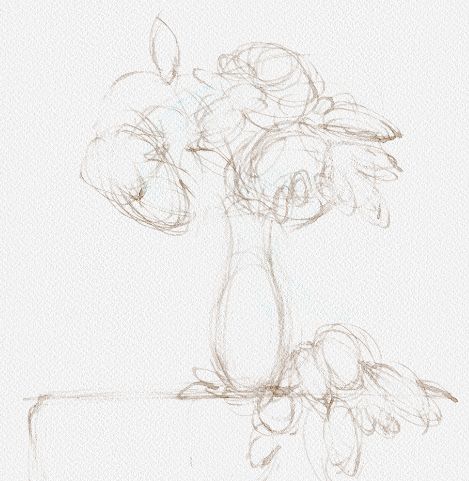
I purposely don’t use straight lines because psychologically they convey tensions to the subconscious. The circle is the mother of all shapes, so contains them all. You don’t see straight lines in nature and when you think you do, they’re inscribed in a circle or part of a long curve making you perceive it that way. Curves convey a sense of freedom, grace, ease and fluidity. Straight lines give the impression of control, division, effort, broken space and hard limits.
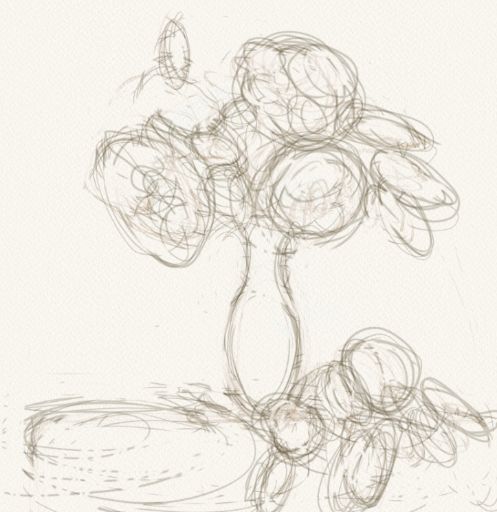
I keep going back over what I did previously, from big to small always, I insist! Erasing
the lines that are not useful inside and out, always starting from the whole with every step. It’s critical not to leave anything out but without any details, as I darken like you can see here.
The hand or the Eye
Your hand must follow your eye not the other way around. Drawing is the result of sketching, and drawing is composed of three elements_ the ensemble, the relative proportions to one another and the different axis. Your painting skills will never be better than your drawing skills, because painting is drawing with paint.When you understand this principle you keep sketching all the time with any medium, then you refine. The old fine art masters knew this secret and the new ones are rediscovering it. Nothing exists without shape, our brain only understands what it sees in shapes, this is how it figures out anything, symbols, letters, numbers, diagrams, or any connections between two things.
Everything around you as been designed one way or another; well or poorly. Everything in nature has a design from it’s own geometry, from constellations to planets down to atoms and even space/time at the Planck scale. Benoît Mandlebrot gave us back what the antique world knew as the gnomonic principle_ which is the symmetria iteration principle of natural creation, and he named it fractal geometry.
This tutorial is only about sketching. Just in case you‘d feel it’s not enough, take note I paint exactly like I sketch. This is literal, I use the same technique with my brush as I use with a pencil or charcoal. The only difference is I push the refining process a lot further.
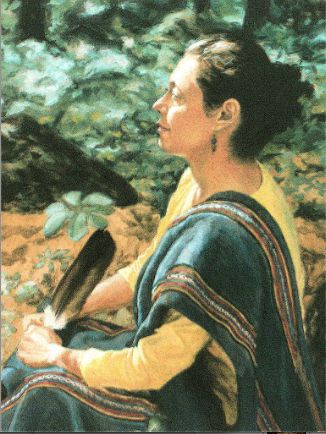
Claudine, watercolor fine art style
This little watercolor study here was done with the 19th century british watercolorists fine art technique. I did personal research to unearth it. This watercolor technique was the trademark of the greatest watercolorists of that era, who gave the medium it’s world renown. It’s a shame they are forgotten today because the masterpieces they painted are breathtaking. I made studies of their work to understand how they came to this kind of powerful rendering. What I found was the old academic technique marvellously applied again, more exquisite and sensitive in rendering than photography.
The Gist of it
To suggest and carefully approximate is more powerful than making every detail obvious and trying to be exact to the micron. In art as in life imitation is not only cheap flattery, it’s the primary way of learning anything. Not only do we need models but we need good ones, extraordinary ones if possible. So I would recommend you choose the best you can find, you can even combine a few of them, and why stop at two? I take my art lessons from any fine art master’s painting showing me a specific solution to a painting challenge I’m currently confronted with.
I make studies of my subjects to get them under my skin so to speak, so when I’m ready to paint the final work, I clearly see how to get the results I aim for. My main point is to establish a solid foundation and never skip the first steps because everything must rest on them. First I get a general feeling of the space (positive and negative) the kind of ambiance I need. Once the basic loose sketch is done correctly in a few steps, the finished painting appears in my mind’s eye. Here’s another crucial point; the vision is kept in my mind’s eye to the last stroke of the final work, but verified with my model constantly for correction, refinement and style. I can change strategies but not my chosen vision because this only brings confusion. If I believe another vision could be better, I’ll make another sketch or painting.
Done correctly the basic sketch is practically half the work!
I keep an eye on my subject, the other on my work all the time. My eyes move like a scanner back and forth from beginning to end because I only paint what I see, not what I think I see. When I paint I don’t think period!
I look at my work as if somebody else was doing it, keeping my inner critic in check, using it to my advantage. I work on the whole from beginning to end. I pause every two minutes and stand back, refresh my vision then come back. Anybody not familiar with this classical procedure would think it would take forever to finish a painting. It actually accelerates the process and avoids eye fatigue. Sketching is foremost a visual snapshot of your subject, it’s done in the wink of an eye. Throw your vision on the surface and keep only what you find appropriate, what you want to see as the end result. In all visual arts the intelligent use of space is paramount whether in architecture, in decoration, for volume in sculpture, the same with photography and cinema. In a different way would you believe also in music, literature and poetry?
It all goes back to drawing because they share this common root. Anything bearing fruit in nature as in destiny, done virtually or taking a material form, comes originally from a design_ a «divine sign».
Khobe
If enough people demand a downloadable PDF of this tutorial it could made possible I was told.
That was.... wow.... I've been working on a tutorial too lately... after that I might add a little more :'D
Thanks, this is the greatest artistic compliment, that my work might inspire yours.
WOW!!! Really. I've no idea what I just read, but the most amazing art tutorial, I've ever read. So beautifully written. So touching. Please, where can I access the rest?
Thank you for your kind appreciation. I wrote this tutorial to address first the artistic soul, not the head. Art is not an intellectual function but a function of creation itself. This implies a specific classical cultural education not given anymore to young artists, or anyone else for that matter. Unless you can pay for very expensive exclusive mentoring of this kind. I decided to break the barrier and give it for free to anyone feeling a thirst for these perennial essential teachings in a general way, so as to giving access to the greatest number possible. There will be other tutorials to follow as a series to complete this first one soon. If you have any questions feel free to ask.